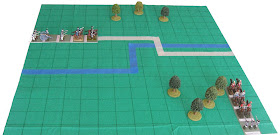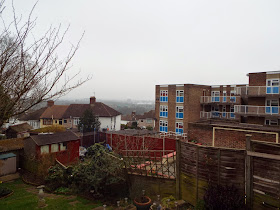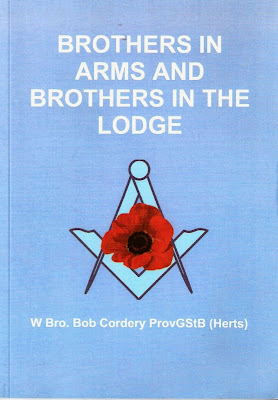Zubia was a semi-autonomous part of Fezia. In fact the Khedive of Zubia barely acknowledged allegiance to the Sultan of Fezia, and had – over the years – acted as an independent ruler. Each year the Zubians paid a nominal amount of tax income to the Sultan, but the majority of the taxes collected went into the Khedive’s treasury.
A map of Zubia.
Over recent years the Khedive had expanded and modernised his armed forces, and although the majority of the troops who would serve in time of war were untrained irregular militia, there were a number of well-trained and well-equipped (by Fezian standards) regular units available.
The recent death of the former Khedive had caused some unrest in Zubia, and although the former Khedive’s son had taken his father’s place as ruler, the real power in Zubia lay with the leadership of the army … whose head was General Ali Nasir. General Nasir was a Zubian nationalist, and wanted to break all ties with Fezia. He was aware – however – that this would be unpopular with the foreign nations who wished to use Fezia as a bulwark against Rusland and from whom the former Khedive had borrowed considerable amounts of money.
An increase in grain prices had exacerbated the situation in Zubia, and anti-foreign riots had broken out in various towns and cities. The worst atrocities occurred in the city of Secundria, where over fifty foreigners were killed and their houses and businesses were looted and burned to the ground. In the aftermath of this a number of warships of the Royal Britannic Navy arrived offshore at Secundria and demanded that the local Governor arrest, try, and hang the perpetrators of this outrage. After sending the commander of the Britannic ships – Admiral Charles Benlow – a polite but negative reply, the Governor – acting upon orders from General Nasir – began work on extending and improving his city’s defences.
The coast of Zubia and the delta of the River Zub.
The bombardment of Secundria
The Britannic Navy's battleship HBMS
Empress and cruiser HBMS
Furious anchored off the coast of Secundria in Zubia. After receiving the message from the Governor of Secundria, Admiral Benlow kept his ships close enough to land to be able to send men ashore should the need arise. However when it became obvious that the Zubians were extending and improving the city’s coastal defences, he contacted the Britannic Admiralty and asked permission to use all reasonable force to remove this threat to his ships. When approval was forthcoming, Admiral Benlow set preparations for a shore bombardment – and possible landing – in motion.
HBMS Empress.
HBMS Furious.
The arrival offshore of several troopships carrying a brigade of the Britannic Army – led by General Horace Willingham – was the signal for Admiral Benlow to take action. He sent an emissary ashore to warn the Governor of Secundria that unless the coastal fortifications of the city were rendered inoperable, he would have no alternative but to take action to destroy them. His messenger was treated politely, but was left in no doubt that the Zubians had not intention of doing what they had been asked to do.
As soon as the messenger returned aboard the
Empress, Admiral Benlow issued orders the captains of
Empress and
Furious to begin bombarding Secundria’s forts at sunrise the next day.
Secundria just after sunrise.
The bombardment was sustained for most of the day. HBMS
Empress concentrated her fire on the Lighthouse Fort ...
... whilst HMBS
Furious engaged the smaller of the two forts.
The Zubian gunners fought well but gradually they were overwhelmed and their guns fell silent.
The two Britannic warships then turned their attention – and their guns – onto the Zubian infantry who were defending the waterfront trenches ...
... and after they had sustained serious casualties they withdrew.
The way was then open for the Britannic Army brigade to land and secure Secundria.
The advance on Zubairo
Having secured Secundria and left a small garrison behind, General Horace Willingham marched his brigade towards the Zubian capital, Zubairo.
The desert inland from the delta of the River Zub was made up of salt plain, sand and rocky outcrops, and the brigade made fast progress towards Zubairo. Nearly halfway to Zubairo the column had to pass near to the 'Kings of the Desert', a pair of large rocks, and it was here that they were attacked by a detachment of hastily raised Zubian militia, supported by mounted desert dwellers.
The Kings of the Desert.
The Britannic brigade on the march.
The attack upon the Britannic brigade came from two directions. The Zubian militia infantry attacked from the flank and the mounted desert dwellers from the front.
The two leading Britannic infantry battalions formed square to meet the charge by the mounted desert dwellers whilst the other two battalions and the artillery swung around to engage the oncoming Zubian militia infantry.
The two Britannic infantry squares easily repulsed the mounted desert dwellers, but the sheer number of Zubian militia infantry was too much for the Britannic artillery and the foremost of the other pair of Britannic infantry battalions.
The Britannic artillery was swept away and the gunners were all slain, and the Britannic infantry battalion that had been engaged in hand-to-hand combat was pushed back. One of the Britannic infantry squares also came under attack, and although it suffered some casualties it repulsed its attackers.
At this point all the Britannic infantry battalions formed square and the Zubians threatened to attack again ... but did not.
General Willingham realised that his advance had stalled, and that without further reinforcements he stood little chance of capturing Zubairo even if his troops were able to reach the Zubian capital. He therefore withdrew to Secundria, where he requested additional troops be sent to reinforce his small army.
The advance from Port Zub
With the reinforcements came a new commander, General William Hooke. His appreciation of the situation was that the quickest way to resolve the problems in Zubia was to land troops at Port Zub and advance upon Zubairo with the tributary of the River Zub on his right flank. From Port Zub to Zubairo the river was wide enough for warships to escort his army and to keep them supplied. It was also a much shorter distance to march even though it was a much more densely populated area.
Port Zub was undefended and was swiftly occupied by sailors of the Britannic Navy. General Hooke's division landed and began to march inland, and reached Zigazag before encountering any opposition. Just outside the town the Zubians had built a line of trenches that stretched from the River Zub to the Zigazag Marshes.
The Zigazag trenches.
This left General Hooke with three choices:
- He could retreat back to Port Zub and try a different overland route. (This was totally unacceptable to General Hooke and choosing this option would have guaranteed his early retirement.)
- He could march inland and go around the marsh area. (This would remove the support the Britannic Navy was able to give and lengthen the supply route the advancing troops would have to rely upon. It would also leave the latter open to attack by the Zubians.)
- He could mount an all out attack at once in the hope of dislodging the Zubians before they were able to strengthen the defence line even further.
General Hooke chose the latter option, and at first light next day the attack began.
Thanks to the efforts of Admiral Benlow and the commanding officer of HBMS
Furious, the cruiser had managed to sail up the River Zub as far as Zigazag. The attack began with HBMS
Furious opening fire on the first line of Zubian trenches ...
... and despite suffering minor damage as a result of Zubian artillery fire, ...
...
Furious gunfire caused numerous casualties and forced the Zubian defenders to withdraw.
The Britannic troops advanced and occupied the vacant trenches, ...
... and with
Furious's guns and their own artillery providing fire support, they attacked the second line of Zubian trenches.
The commander of the Zubian troops at Zigazag realised that the situation was lost, and ordered his men to surrender.
Now that the bulk of the Zubian Army had been killed or captured, General Nasir had lost his power over the Khedive, and the latter sent members of his bodyguard to arrest General Nasir. The General had guessed what was likely to happen, and had sought – and been granted – refuge in the Gallian Embassy.
Having regained power, the Khedive sent diplomatic messages to both the Fezian and Britannic government requesting aid in restoring order in Zubia. Both countries agreed to this request and within months a newly-formed Zubian Army was recruited and being trained by officers and NCOs seconded from the Britannic Army. As for General Nasir ... well he proved to be a growing inconvenience for the Gallian Government, and his untimely death from eating a surfeit of oysters was regarded as a blessing in disguise for all concerned.


















































